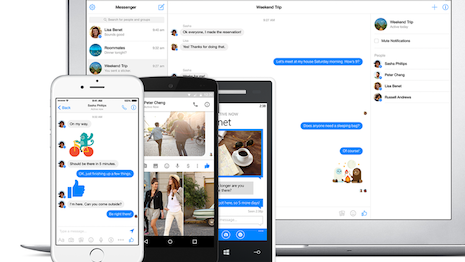By Kyle Christensen
Look at the chart-topping applications on Android and iOS, such as Facebook Messenger and Snapchat and the ones making the most money, Pokémon Go, which recently reached $500 million in revenue. And think about what these apps have in common. They transcend what we typically think of as mobile, allowing people to add a digital layer to their experiences of the world, whether that is catching a monster, messaging a friend or a business, or sending a filtered selfie.
As smartphones get smarter, they are also becoming more integrated into our experiences of the world — which is the promise of things such as augmented reality (AR).
Thus, our phones are increasingly functioning as conduits to experiences, rather than experiences in and of themselves.
With mobile at the center of planning and strategy for so many, this shift demands that businesses rethink how they connect with people, prioritizing human experiences over a channel-centric view of marketing.
Experience reigns over technology
While customer experience is hardly a new concept in the marketing world, recent mobile developments underscore the extent to which experience matters more than technology.
Pokémon Go is not a breakthrough for mobile or gaming technology. AR and the game’s mapping technology have existed for years — just not in combination with Pokémon IP.
Consumers were not playing Pokémon Go because they were obsessed with its technology. In fact, the game was crippled by server issues. Players are addicted to an experience that adds a quirky, digital layer to the real world.
Similarly, seemingly everyone under 25 is on Snapchat — not because it is the only way to communicate with their friends via mobile, because you can easily do just that on Facebook, Instagram and countless other existing networks.
Nor do Snapchatters care about the app’s facial recognition software. They like how easy it is to snap a funny image, or to add puppy ears to their selfie.
Snapchat continues to grow because it has figured out how young people like to converse and consume content. It will continue to be popular as long as it makes day-to-day life more entertaining, easier to capture and effortless to share.
Mobile is promising because it enables multiple forms of interactions and conversations.
The technology behind the scenes allows businesses to create seamless, omnichannel experiences that are all but invisible to their customers.
For instance, with a few lines of Twilio code, companies such as Uber can connect drivers and riders with the tap of a button. The user can easily move between summoning a ride and texting their driver, rather than switching screens or opening a different app. The phone itself disappears and gives way to an experience.
Online/offline distinction is fading
Rather than considering mobile, desktop, in-store and so forth as discrete channels, businesses must think about how to provide experiences that customers find compelling, however they choose to interact. This is not just a broad business imperative. It is a change in how marketers interact with consumers.
Consumers do not think about being online or offline, on mobile or on desktop.
Our phones are almost always within arm’s reach, and we switch between messaging, phone calls, texting and browsing without a thought. We search in apps, in our mobile keyboards, on our TVs, and with our voices.
We use our mobile wallets to make purchases in stores and chat with customer service reps when shopping online.
Because our digital and physical lives are so closely intertwined, we do not think about our actions in terms of channels or devices – we are just choosing the experience that makes the most sense, or will get us the best result, at any given time.
The customer journey is complicated, and marketers cannot simply analyze a series of linear, digital interactions to understand what prompted someone to click, download or buy.
According to Google, 90 percent of consumers use multiple devices along their path to purchase — and that is not counting different actions on the same device.
Marketers will only be as successful as their ability to integrate different data sources and create experiences accordingly.
For instance, what information might this person want next, given what she last clicked on — would she prefer to call as opposed to search for information online, given how close she is to purchasing?
In a rush to keep up with the digital consumer, many mistakenly focus on only new or hyped channels, but customers are not moving 100 percent of their activity online, just as they are not using Snapchat as their only form of communication.
When customers want quick answers they want a chatbot to answer in a flash.
When they are making emotional or tough purchase decisions they want to speak with a human.
When they are buying a high-value object, they want to see it in the store.
Marketers must create experiences that reflect these preferences, rather than blasting out messages across the few channels where they assume they are supposed to be.
It is why Facebook is now helping marketers make connections between their social ads and offline interactions such as phone calls and in-store purchases, and I will not be surprised if we see more of this across social and digital ad networks in the future.
THE SUCCESS of apps such as Pokémon Go, Snapchat and Uber proves something intuitive: businesses must create the best possible experience for their customers.
This does not mean shoehorning a shiny new technology such as AR into existing apps. It means paying attention to how people experience the world.
Businesses most successfully reach customers when they think about communication beyond the so-called online/offline divide. Only then can marketers provide the type of experiences — seamless, personalized, engaging and real— that consumers now expect.
 Kyle Christensen is senior vice president of marketing at Invoca
Kyle Christensen is senior vice president of marketing at Invoca
Kyle Christensen is senior vice president of marketing at Invoca, San Francisco. Reach him at [email protected].
{"ct":"C\/shWuYmDZjF6jRowqECgTvl5wJ+7s7WMquEh08Up0K1LvP2z91QEOeDVycG8nUzvkkvMGk13ERwJNUWN\/cIHbbwwWP5a4GAa4cU0qzAf75Jv+rqkpnONRNaDa\/zo\/t5W6SqoNoiH\/2KOgKvtUqbDUBMSdYMMNLF\/aAJ68Ohu5LBgbim7TWtxprrJwSI2BgWKsV0TVpeFp+QXgogj\/flDyQC9baOZIs3x9DBxF3faTYiX+LjlXfbUGs0CJMHx9qlbeoEDldNWIaa6pf34heQ6Oen5Id6c4TSROH8MgjXibwoBMBKrBxXo9jcmQgOPDaFxG0LRJ5HtznBJDaUnJQJTRMEWe3EDaIBW0+LxhF07oU6u7zxL2txDUzH70S\/x8A1z8PC7gdsHAcdKzYpWh64Rw+ddHPdL50OcCV88I+B2H3VMMaHHS0Hnybq0Nw3C8P7J092D0OAnjli9o8mPhCcTFCHGxRJ\/q8AYahMKBk079fl0e5c30MyK\/hj0LU+xxMtvanAfZmrZTA+jVjQ3tySR2wMAaOYKlnABEmJbj1c9ph2H2Mez9GLOyHN5AGtOegC8b+bnI0RCJirRvMlVt53ZMtPTdypFivp9AliY7JaRzUtBf6ywYlhDQx\/GxwyPOkpuNj7calRiRN0c\/cp8K6VJ1A8E3hFP7+9L655f6KpFjAf9AtG0rYl6rbThCMrSS5BayP\/7xKPMmQ3rbdvHVXrNQNAs05HwlxLwnWr+BuH42HI5hDEqVzrtv3kscI+1wUze91RGR+1e6D3yDV6GhcLEqrA6Ln64bLTaz7iE6jpByQpB7xaQIPWzAOZ1+7CWdF6y0eJ7B9v6urCfxK9z8A7T3YcPMiguy44n8grPsT\/VgJEcjtAlCI06N+ntscrKyIv8fnUBTUZo6ZfID0\/IKh2RGD4Uk6rowyJgL0DqOnJwwX1Us6TGoSPjoBO9dfEbKJyDH2yfGKlziSJIa5Af\/KQQlH8MM0\/DD5YGr1M+kwQJRvBmqmlUXKOA8Wdbih2UR+uf8UQCKc2l0GIkI+7N0sCicCF9W5u5JgYEUg48lwXPPoD3fF9P\/BiifegovRdWo1m9Rs3WWl7bhPN0VnMXwQGHlBHvUGVUfnZmondOjtgruJLRi3lc6dkm0426UzHauwF0lp3ZCoEH3bWARwGezcTNrlBo3LkHCfnB8jiwV\/uPGMm64ZFGW7jrPMt11IHuuCTwbHEJWcuNNrp9Sq1GQ3IAfskJyD6MvZrpoIbG5cAtBmTf3RGqW6AMxpdOpok+I4gFe0KSVjsgBYV0\/G5HXje8At3fEETDuAK\/5cqHfIdj1UN5jVqWCtdk7bKrYHZnEmA0AaK6HE9WAgGp5If0nkM4Ux2rMcACUN4TxQKy9M9g1KVeI6IRUtlXSnRJLU8+CeoJ5c4QXIypyk072u\/eDBduY5pP07YxCx4ZWs3qq19+VyLgdXsVqPFqoA3srbFPPxXezW0AkIryJpy\/TQTC+\/DS77sbg8OLv+jAlcOgiVuB5CJ+NL8SKvP1jZXXBU5ToJ1DYBWkzVtTASHE\/NjorJIt0Th5yeavvOUdN73\/ToJI8VE5RDaadV3BWXgb0E5oE\/nLRqzWPrkYNpiFzWhKoN1DXjqj1NMRaeWkzlLeEkQPZ92gYK54FdypkIhJl6+aAQA4DRK2ylj6sV\/jjvZyLkhR5Cm4MdSSNho7IHbZ2\/iz\/1so\/nGmp2Ue2iX4TWOO4UNb2X9zR939ZpqwntpHkt1odwNC7q11knmsxhQZL\/HUwVxlsCgYtAKtOrnGLew44MG18txdlA9n5gFYGqJ6asM06qFAjuyfivxSFJO\/2n5c\/M6OHvxgSWaNSbgTQeGTUouszWY1OPdPH4EOTc76j5Hseg3GJkFRJ+9SlAKXzsxP+q22JAae8u3mDJHlC7lwWD1deibr9nvbmV2sq7qaq4yj41g48wByKUe+7h0Y9HVGC1IjKPHwrzwECxDiAhbOAXyftIt7ed0Ms\/YiL4Z8t2zYx1XAbDqiPLfP0D\/7AE8AcgtKATVXy0PyMEJqZEobzKqGB+7gXc\/nyoz6NGHcmJ4MllN7ptXXfFqmvNK+O1jXKN3jZpInoacFtLgtVVLG5luEBfiVDORYu5\/eMpAF6eIRlFfEzFHBTbWy7MNGJwKJC6L0ikYjd3gQ5dRemG4zkXSR+LVxf5iUsIfsWDDZo75tg7cRD74WVxEJ9Hx9b3BNcX1W98fmrwhX0MsealT46hSHWgP3oK2r4szh7jcHrB3NHSViL4i9eiATd17\/qJVO47+Ym6DysKe\/3dyLxgr7A5JSHn3BP\/XVg8pw1hC7EuU4jQzNzYfcfGdawrQD\/i3ynuniXDNdqCr2RSa0FSsi3Bv8XrGRrJK3yQUrTUcEr7LGsBZ9IqSDh3uIbMWG24WkBl2iGgy5NBga8lMBEhEJPPzjijP8SEZ\/IZwyaeK\/C6alkBRlY8f6E2SsNITtriqOH82Sy2a4KzP\/k0w9aWujwOaKNlTo\/B0NZg9ejrn0PnXiNZ1LBzXBll7aHwatyqTqL0TjFNheRXKipr4N+yIDbWclVOBHiWydCtc4tn+OeHxVugtaNFfkPgcLbiy11CDZ\/U03BEzXd0DkzrdqqzMQcrdkIkfEEhIy0GrUaSSOJPl50xnv5jhdempvlwpRtJVSfWp7PoizwxKeTwtkeKCYzbiIHVMAwFFmdKvBG1dhgZR+lJ6Q4KRG6txUxs56t1I3gd\/UII6jUiZUxconqVuPhVUymVsIuK5P\/N1LB8LzZUtjmvr6zh0raf\/xkCuvI8YhstBKz61s1LQvNXsZCZFMPlyJe3rCduUatPE73TwkI4cVdJF2EOzyKgfI0hJk9zJkyvQqIosKkJmixFkKtZKD5vnPYjUj8b3k\/xhVXxJoQ3GkMVC8OI05H34YFRpMYYjvaUa0wMWNchOrvxIqU9AgGv4hLanDf0JMc7ITx4P4OMvY3g7H1FuudgA+ZhWV3gtf12atbTnbPojTELPGJes0TyTvCljqIhaiNm12gdq7UIwfQuuHBAYJ6yxrfQf2i+KgNihbFjjv6Jon2kKOE2r6TjpMRtRkXJns9fdl0KsolDGUyU3xol4+3hIBveM4Zzio0czBS5IZC74TuTokLcHWaVCy9qN1qaYaaWQTS3WspgFpvv8b\/Y8MQA+eH3\/R+qCQek8Mjgij8y7TCdcIpN4WbXVq+u10lp0cFOttj6UKZ6xc\/A98AqGWdVTwqjl7WIs1\/TZN80T8gy28cRCCS6zg7h\/QJRTYBrW9\/\/yQOahn6ZZm5sZK06mhuY62MWC7XKtcqny1B0QcNE\/1o92et95N4utzmZBbKnl58qxsKSPBH77FcnKe3ftKR+O912q\/ZdEYJbZMDIBZqx0umgz7vDVfn9jyWPlgkR\/5CSKiHUazUVUuvSA9RA7p8k3dcJLVNKEQ2hYTRGxux2\/pHqdid\/5HASnQa0abZZrYBWbWNbRfq0jzxnM7r7Gl2QKQLoFTL0IwFbcsyjJiswn7P0zieFjaFoaNO3GtG6tfspV89RxOCnD9Clv9rm5HYsGbqYGO4xiM3S7znnFOe1Jc0yQ6SJST1Af2VXl75ywzBTDVHcKxoxPliIqkNxkZmZMVvqIyJur5lul+oB065JO+8EL3XvbOaIUndjQQ284FmdCq7VDnIOxOL\/GE2oMJJi+Fwi01NGgRwmuNeEg3Rahz2PuCYcilOCEwIKoqowxz3cnz+cFBRqNU7hHqojN8zbFuKKgN5Gc6WqbFqVPUwdn8XcM1932ML7fIDk0e\/9jpN3Imt9xnuoR+CgBXGkeVVribgK6+TbWXhezAkK0CixtJPvezfBlhu0t7clk6Laus+oX+kvS2IR7lnCyPymPX7qjaY3HiRK2+kUUfeFXHoqMA34mvehkIuCuTcCHyibpdF7XdZ62x9efS\/kSNql0eCgbdMaXMqrnn1gsJ7lEw0usbVE7YoYTez+7jEkZUAO\/lGQ5u1DhJO+H1n+Rz645gL24WjG3pXUc44dgTgF6EkPBqp11ZghdMqY+KEBo1EKQQbfxpH\/ZJYbv7j0UYGUlxCbXzCaWlAWX1iAxfreZipLyd8kfERXWh87eOIrdGqqVsN11koiWTTPH14c7ugViKc4+H2srVmzGDBI4EEt\/eppoPa+CC\/QKsHNHbbYi9V6iGdu0U5V\/CVLjSR0m+R5aUydvPnHlqrVw\/hq7uTn4iVEuLUxWAsOmcuU2NNSxhv+ZEp9tuhdSzjzAs15ipnJGDy3E8vKEFr2ADvzpdOte4CifTqbpktWTYhX3ETeq78CFtpOEVfyMTP8L1PuXy95PmHXdFRia6elsuygzpcwyaXVEoybwj3hv1tSjnFzjPXus\/rPyHAAd5NIGmOuUBTlCYL95YW7JPvDdJ1v+lPZFi\/Y4QXlQn0rCvDuI\/2rxipvKBZ3CxDL086nOrRdmgeznqJotkh5BCg5rgOJud4rHoDhGcNGWWi3ZQsFfNV\/\/Vlzc5HrLINZ+FHnxOD0FoPqgSPQhZSc4TQ2K2+0Nsx7boZnSblq4KWToFe\/irPuz5sCOEPzd4QW2JBf8S76XI8Wr5E3rm2lIWLG66hMRaXndqn7AQ5cTGDl7y+NhatTbhONsR11+3ids7BAwgd0a3EEbrwxLZXfHTDW\/lPSrNUSgFiuyjy\/JWvNGkc4scwoaGBatGazM7Gz47Dvi3O0nPDkR9T\/4gBrOIeTSfqnt3tbm1uW19j6VcBMpVeEbibyUd4YSB0FIGN+NiQE0zFDMdvEQiXiSFDr0ZsT+aYHtNg0eeUq8QjRDTwajYBwHq5G2BLtFh7nto\/0UyscgKanJlO\/AgjPU48kqNB7FT20TspVWHpPmstVMtZYvnlnknGrQGvPwQQ1GZo9fMs5h9Jk3UvSecFMnRUAp1eEyxJtOiGcBVU3qXGlYJPOR+q05IdXyO9hbr6Y03QMNaE6+FPYLGiDAspbZ1zv3d8u6x7OOY4nGqCgew5mn8no4NZsqmO6ZHFsTdcVjRQY0w4ja+zxoLVLSTM37oB116oJ1osmrZDvMggaBcxqls7aGcSpZgMRtQd\/Ug4+pQwFT9BhhoDsrJHh+RfXgF923mIkk7oqCj7tP6DI+N8lwENN7KUi7IenimMNXeuaqb9PEppL9C3nRyeXmV0c7pwvsAns+oxNR3dwiVICp6+WVtma+z2ccaRGbfNFQeH3Q+v77KTv3qAT5Y4aig1ibUOwOOF7BCObGep99Pws6IC7o5TC2lWCvXnFzLKB1LjSzsdmKxAyIKQSTMnK9mLvWuvwn0X\/If80zRmPi2iawXfBAy25VAgzYWDwmgrVtlUzE3kJTkgKoFntst93zQyDKpy2L7xdizJrgycmmrVTaWpJTNkwRQcT3\/Rrac7Kr4CCw4I48UFT9VqBdYBg3qYP7mVgwEYIvblTPmnhNWOG7RoGnGwuO0VoV5Ah8PrTZMQjGZBe3D6B9dKgYSEcLvL6RVHSI6X4DNkMabKe+eg+ujw1g780EhbiG36y4\/5ykeyQ5GAy6mw87EUJynW7TwTSRzLasQjC9XSsp9sj4IP5ckIEWFM0m6UtmqOvlRooCEp\/KlU6St2GjYE6RClgVjWkTJIAul6TJZFNiQmtLDcHq3uueWHAH8b99JYp+R2uohuPwPFqnVaPhuunf5D9PSci046tSU8Oyvn8JJt+A1uzz31WIkcFQFndtZWI7CzXpDtg+Bws\/a2IVEbl\/W+shVXNaI4waCg\/vpQuWuy8koB59OhkDsmELIRgplbu832sLTZpqHPQC1Jgi6iYakODexAUHpBHKG2n7GAEGw1Cr6kRlVgXcfvhzRZjkgbV6WPbML1+O0a6NEOwjktGwG1jjk2kNNKFqgwpG8uyrvEfSy\/fQpmpMmNnnD\/4n6OHqLf\/S\/Kvt8LieDB2z4MrtV6ajLOY\/pS0mpVqdMzMnFcSRFgyO3gNe1krk8fs5bc6+RHrRpjGVxWWRnMvgE2fIWkLtYOiojXeOlKb9eiG\/3OZECZCd7DvHMpaA7cIWPJSgWqnC5\/hmpzSM8g6nZQbWXCvT+0VS+zw6p5AAWh1OsC9OLz6OywiECvyAFMfLyFgjTLFCd9M2+EPwjMn0yYgwmLZu9ECnz9rxCmIk2rImd\/siGwGSn6wXOxvqjySoHmRva\/7BGrhTmhX2\/IsAvFLudEOfDsMz+wnvB8wEDNM2hXVaOWe8pYW\/\/G4tImd4zqvYE\/+hcTSwqe4m44XycD\/zW3oo5wum4G23xQW\/P9wjMulaqho31Usd5\/2jgM1eXpWKz2FQXHOcqFK6Kvs32dkktph44DTkLlcnANKZePLPtFH1mOl9a0+AXmftn06wGG3xCaKvwLA\/ZyqbvmSFh\/C0vnnX+uGYNpfYGhHgM1iZdk1WXhINHfDsvJGc1H2YN5f\/3TqHM3sIHAT\/WnYJJoaDMDEZPfb7Zj+ujiv+CND+Dgjl6f9nEajJbHCVpcRfnhc+ivN2ASy2uW8cylLEURn6E33\/mPb7OTS03KuIvO9K2enTpc6KEk5OtsXsZX12nTx18\/\/JbuJo\/bSV0nDvGjh6NjCDkOsgg+nVTOPEveesvtag+PSJaYjObzqJdgY\/eAXSuBpQWk2YAfk0SJT0iKKIuEG1NvY5EuGM\/PMO4oWhPGpmcMtu0Xvu2dUcdQvxZbEOps21WGIbW6TXJOxhBhVRq+NGByLbW3VHv0h1zo7DSCZmhwmRmSfkfzhifu3k8zhor7t\/NSto\/i+FT8\/fLWg8VdjORnCVeZKyQqcL7UBM0\/7GPnLoFOTsSIr8Po7mIlTUG5cNxlT5dZGVAHPsYX\/S9r5a4wy+D9ZMg4QqE8LvZMT1w0UrwffqE1aM1A7i3A09iGHfjNYe3ZsK0v0YQ3dPEfM5CR0+XMJZCBcsNotqnSnw2DdT8rZS\/w3k0PJk2moI7rQVawqyOt+W\/x9\/csRm4lx91T5wMyyJ59Cl\/t1FK2O+ODCQiIDxajRhLFUCLalWTrp0GouXRolKfr1mbP3P5IXCOTsVg6qcHHX0T0RPSEGSre728vLgXUXLbbczFtujgTT\/YbZRe5TY6jRarxZFQX2mUxnXf4dZZF30vD+8B+owxR8cGD870w4emewRvmGqFLze7hCQQGtMqs\/bRT\/artEPkAMxzohh7rM03ushEMrdMIBDZVy8r4gPVcOrxcntdTo50oNavDP\/aUaEggrijGBtnJcP5yZD9X4dBjGS9QUzygye6gyKMv9HdC64Pvs9kq1qX1E58HnoIvIWjobYk8UFZESzCmS5bC4x834MGs6XgcI0TGM4gL2ISvuNJcR82y6dh639YszXeYPscgW+B9RHGtQ3q2d7eZQsrPoiRhn4Ck6L+nD5+8Hk\/Wi6t4m4YIqYO6JkijO+sCzOFOA0VrsU14VajNd6CpBSZcoeR5hwqXR0t+isd7MXe9qFbiehy2qVxQ0Xhwouaai9a1pL9NTan1PP+Wx\/R0zKHcJCaxUMLNGPixvFN3g6I6JSsdAeLPpvvIxWyr1lipdQ9jwFI\/LaXePYYseYh\/KYnY3yFLwvoZF26GR7Lt09wh+kys27Uurv3GPsA8jwYkBahkhGzOWLLA8JWpKX3z6hdfYUfDgLKMWwwggeylw7vajGBYMKOcX4ZCbztPbLhCJdofwLu+GTge+auemf7DtB5Od33CbitS7511kFu\/K4UYLlsdtJ4ob4dJZG4ySjECWnUr022bdLV0YecsLsZYnpc\/HvXeaHo9IgTRI2oqNx7PcTQtfIH5iM+EY7YUdTBWYY5raQpLbUD\/E3z\/spcVkBB\/BitLWM+hn024oR4s6Og5vGK0qB21Lx+doJqcPBTCjj7wp5YkhUq\/o0BpKLgHhDR9lwNX+vofoZyUgUfXLM0F05e0TdPQKIUPMOcPdhh3U6ncAwPT9o7lguamYGt99DnOCHgNWv1tuEXbhS3rbgFrQBsQ0dAm0d4IJXpyjy517uHIZGpmkZa3b0EJFt4kGNBRQIjcQHCLQHfS\/JI4gccXF\/T0WZr5Z4BS2+gvbHI7ublG7f4PxbfpcdiSJqBBUE+WbavPMC3\/Fg7Ucc5GCB3Fk5Ac9OotkTmuiztfTaFQDzF0ArtN6oNsMvTmLFYPrTpkCQrexOqExNge1QViTNzWBBgIby2xZH2B5tSvv8NhTCkJKHzKwjqB4OZh3fOlucPoEjYRMo+a9iNIhzX\/f3jFyMRgOQrPv3Z1\/P76KGI1cU1MFkSr0EqbGTcbVRaVNym7JtuTz8p+wvr3ZVeDNko4R2VTTRVqHv9e917l7jYKYHxZttlcAbaB0\/WmQMsPfwk+Zjl1YNFza19Mi7gjUbKAQzedvLjQ7rs8VdHA3WnDmrIKb3F264LG4XtPG+kv9xYFUmz47M0i97atfm80VIjUcqlyZemIIlbVK7V0XzeegcFK4XGajG9L1tB5pGvxElEmnmYTNNsD7YjR6IoHeVCb165JzKOe5HQWN8sAIbZplWHxJP2bBOghotMKga8iulvXWQI4DPLROpQ1YcnsAMmPCP75O4CSG0h6SSCUQgxWkk7sW1H0THTK+W1a3vtsg3NGe7aeDmx0ZYnqIOArlCdZbwWaDkPE+Rwa8gzK+d+lIJ2NE1xWzVIB+iXHBDYWCF0h5t+2xbMQSh4tfUTa+rkkNATp8GZ4sfiqejPwSUoBnmhfFK5AOLln4fLOOcjLu+rJnnYIPlky5IxxDELyfXMnhUjSvxZl5naPaBvPSz06gnzkHGB+RmY2C1JN3kO0\/5cBeMkowEFWr87m\/YQwAvdgsnq+PcwtIsrC47oKKi9DA7nMuFvSjgtKcawfKGr5En9gc7INbIy6pW8YkDPPkRZTF1LkxjYUSH2+tDQiWro8IfHS7lcVzQCZMuNO567mGuTGmXFRMPbXeFEKwBeBxWHdf\/N9ZMxdtfnHPAdS591ocxN5XMn0cxitparlWlLq+NLLFd38FPfo+i3JQADhBQQVEjUL2WdUG7NqivzmQccKxn5S5e8jCpUYxq9hwYMzN+dxn7Ad1CpopZJUa8c0GHpR8Ync0KzvuQa7Z+ACED+jlx6mqgF6PSnqchvwKsqEi6lQMdmxGTg1mkNA1DNHiOjX0XkcHVvfAFeCFHG+\/NrTuzFRQf\/9VyAq0zDdspQOpLcuTDIW19eQf\/M8hc9+R2jrgl\/QerOu5MWXjuLAZI1lSVPUjAwMy7yQpYTxEbBaaTCDtvCILdzq8VjflIvZqiwQ0Ot9aLC66z692laljtlOeM9yFklYwM7VRqpfANVbCSPP7B764+JtOv+0sjGmYpCkcfjKmNb9VRCiquiYdyUqTNOfOVkzSdSIstE0VFMGH8UNy64nUxVeU566nuwTk3ea2oFGCw5Pj1P39RDYlWvhegoEf\/trtfVa10IQrM\/7buI4o4HbjdWYHeWF5MxNNZEOkPyMoi37EsN9d2o+vTNPUAwV1WAD5J0y7F1rRtN0UMRR6Hr5WkyOG\/DG5NPq782+FnZIOoppNlUitN8Hz4AVwhnjvBKkd9HqTy4CJpCNHx5Fw=","iv":"674ee81484e9d529620105eea77a5bd7","s":"664b0d4891ccad29"}

 Facebook: The medium is the messenger
Facebook: The medium is the messenger
 Kyle Christensen is senior vice president of marketing at Invoca
Kyle Christensen is senior vice president of marketing at Invoca